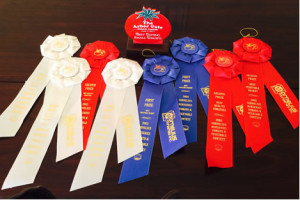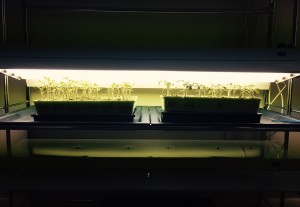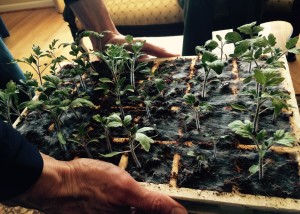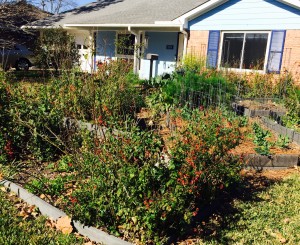The kale from Whole Foods tastes very much like the kale snipped from its stalk in any Westbury Community Garden bed. And many other garden fresh veggies are comparable in taste, if not in nutrition, to the ones bought in stores. Except tomatoes. There is no comparison between the sun-ripened deliciousness of a fresh, homegrown tomato and the dreary flavor of a store-bought one. Expert gardeners Roy and Shelly Johnson agree, and this is the root of their tomato growing devotion.
Roy Johnson grew up not liking tomatoes in the small town of Junction City, Kansas, where his father kept an extensive garden. What Roy remembers most about that garden is there was always a lot of weeding to be done. But then, he thinks, maybe it was all the weeding that ended up instilling the “garden culture” in him.
Shelly Johnson grew up loving tomatoes on her family’s farm in Castroville, Texas, and later in their backyard garden across town in Houston, Texas.
It was around the time that Roy met Shelly, both college students at Rice University, that he decided to try to like tomatoes. After they married and later moved to Westbury, the time came to discuss planting a garden. Roy said, “I don’t like tomatoes.” And Shelly said, “No way are we not planting tomatoes!”
 So they set out to find varieties of tomatoes that Roy liked and that they could grow together. This began their award-winning tomato-growing partnership.
So they set out to find varieties of tomatoes that Roy liked and that they could grow together. This began their award-winning tomato-growing partnership.
This season, the Johnsons will grow five different varieties of tomato plants in their front yard garden bed and four varieties in their Westbury Garden Community bed. Of all the varieties they’ve tried, they most highly recommend Gregori’s Altai from the Altai Mountains near the Russia/Mongolia border, and Russian Persimmon. They have found many Russian varieties do well in Houston because the genetic ruggedness that allows these plants to thrive in the harsh conditions of Russia apparently allows them to do well in the harsh climate of Houston as well. Unfortunately, at this time, commercial transplants are not available of either variety and you must grow your own from seed.
In general, the Johnsons have not found hybrid varieties to perform better than a good heirloom variety, though there are plenty of heirlooms that do not perform well in Houston, such as Brandywine. Roy jokes, “If you only want 1 – 3 fruits per season, then Brandywine is a good choice for you.”
Another variety that the Johnsons highly recommend is the Sun Gold cherry-sized tomato. Roy calls these tomatoes “garden candy” and says they are the ones he eats when he is out in the garden picking the other tomatoes. He’s found that, as a rule, the smaller-fruited varieties do better and recommends that gardeners not try to grow extra-large tomatoes. Cherry tomatoes produce longest and the most.
Other recommended varieties include: Cherokee Purple, Black from Tula, Heidi (roma-type), Kosovo, Big Beef hybrid and the Lemon Boy hybrid, which they have found to be surprisingly tasty for a hybrid.
During tomato growing season, neighbors often stop to gawk at the Johnsons’ nine-foot-high tomato plants. When asked how they grow such robust plants, Shelly responds, “Plant them right. Grow them fast.”
Start growing plants from seed early to mid January. The Johnsons buy seeds from Tomato Growers Supply (tomatogrowers.com). (It is too late now to begin plants from seed.) Early nutrition is the essential component of “Plant them right.” Plants need food available (fertilizer), even when very young. The Johnsons have found it doesn’t do as much good to fertilize plants later on, after they have begun setting fruit.
When starting their plants from seed, Roy and Shelly mix up a gallon of liquid fish and kelp fertilizer (SeaPlus from Johnny’s Seed) and soak the potting medium in it. They then place the planting trays beneath grow lights for three weeks until the plants germinate and reach a height of 2 to 3 inches.

In January, seeds are planted in trays and live under grow lights.

After three weeks, these seedlings are ready for individual 3″ pots.
These seedlings are then moved into individual, 3-inch pots with a similarly-liquid-fertilizer-soaked potting medium to keep them growing fast, as the growing season is short in Houston (March-May).
After two weeks in the 3-inch pots, the plants are moved to gallon pots and kept indoors and outdoors, as weather permits, for another two weeks. If, at the end of their final two weeks of potted life, the weather turns cold, the tomatoes will not be planted out. Shelly explains, “It’s better for them to be unhappy, than freeze.” She remembers a crazy late freeze that happened one year after the plants had been in the ground for a month. Shelly and Roy dug them up and put them into any pots they could find that were big enough, and brought them back inside for the week of bitter cold. The plants were not happy. They wilted and lost leaves, turned yellow and sulked, but they survived and thrived after being re-planted out. That year, the Johnsons were the only ones they knew in Houston with tomatoes.
According to the Johnsons, planting out on Valentine’s Day is a gamble that does not often pay off. Cold weather slows growth. Instead, they recommend you buy sturdy plants in 3-inch pots and pot them up into gallon pots to get a head start, but be willing to bring them inside when nights get chilly (below 45F). Be sure that the plants are fertilized lightly but continuously by watering with a balanced fertilizer mixed at half the recommended strength, letting them dry out a bit between waterings, and protect them from strong winds (anything above 7 mph).
Around March 1 is the best date to plant tomatoes out. Each plant will need about 6 square feet of growing room. A raised bed is essential to successful tomato growing as tomato plants have extensive root systems that bog down, can’t breathe, and drown, in a manner of speaking, after a heavy rain, when water can pool and stay put in Houston’s dense clay soil. Soil in a raised bed is looser, has more oxygen available, and drains better. When you plant them, sprinkling a bit of bone meal or rock phosphate right on the root ball will ensure they have the phosphorus they need for early growth.
Tomatoes bloom and set fruit in April into May and are harvested in May into June. In June, bugs and diseases start to take their toll, so yields and quality suffer. Early Blight is the principal disease of Houston tomato plants and is transmitted through soil contact. It is helpful to pick off the lowest leaves and to cover soil to prevent soil-splash. Mulching also helps keep root temperatures moderate and aids in preventing soil-splash. Even so, plants rarely do well past mid-June. Roy counsels cheerfully, “Don’t get depressed, just pull them out!”
Nematodes are another serious pest of the tomato family plants and thrive and multiply in hot weather, another great reason to pull the plants out in June. To knock down the nematode population in their tomato planting area, Shelly & Roy plant cereal (grain) rye around October and let it grow until about Christmas. Then they “dig it in,” by turning the soil over to bury the rye plants, the fibrous root systems of the rye having done their work at trapping nematodes and reducing their populations for the new tomato-growing season.

